The Influence of Construction Methods on the Stability of Tunnels and Ground Structures in the Construction of Urban Intersection Tunnels
Abstract
:1. Introduction
2. Urban Tunnel Construction Methods
2.1. The New Austrian Tunneling Method
2.2. Construction Methods
3. Project Overview
4. Numerical Simulation
4.1. Structure Simplification
4.2. Numerical Model
4.3. Results Analysis
4.3.1. Displacement and Stress Characteristics of Rock Strata
4.3.2. Deformation Characteristics of the GROUND Building
4.3.3. Deformation Characteristics of the Branch Tunnel #1
5. Discussion
5.1. Evaluation Criterion
5.2. Construction Methods Analysis
5.3. Field Monitoring
6. Conclusions
- (1)
- The CRD method proved highly effective in averting engineering disasters and demonstrated superior suitability for urban intersection tunnel projects from a safety perspective.
- (2)
- Construction methods did not alter the stress variation trend of surrounding rock but affected the variation degree. The influence order on the stress degree was full-section method > step method > CRD method. Specifically, the maximum compressive stress was 13.80 MPa, 11.90 MPa, and 3.56 MPa, and the maximum tensile stress was 1.31 MPa, 1.14 MPa, and 0.76 MPa, respectively, caused by the full-section method, step method, and CRD method.
- (3)
- Construction methods did not alter the deformation variation trend of the ground building but affected the deformation degree. The influence order on the deformation degree was CRD method > full-section method > step method. In detail, the overall tilt values were 0.00338‰, 0.00323‰, and 0.00354‰, and the maximum foundation settlement values were 0.532 mm, 0.507 mm, and 0.556 mm, respectively, caused by the full-section method, step method, and CRD method.
- (4)
- Construction methods did not change the deformation variation trend of branch tunnel #1 but affected the deformation degree. The influence order on the deformation was full-section method > step method > CRD method. Specifically, the maximum vault subsidence-affected values were 1.881 mm, 1.588 mm, and 1.428 mm, and the maximum horizontal convergence-affected values were 1.264 mm, 1.157 mm, and 0.931 mm, respectively, caused by the full-section method, step method, and CRD method.
Author Contributions
Funding
Data Availability Statement
Conflicts of Interest
References
- Zhang, S.; He, S.; Qiu, J.; Xu, W.; Garnes, R.S.; Wang, L. Displacement Characteristics of an Urban Tunnel in Silty Soil by the Shallow Tunnelling Method. Adv. Civ. Eng. 2020, 2020, 3975745. [Google Scholar] [CrossRef]
- Jiang, C.; He, J.; Zhu, S.; Zhang, W.; Li, G.; Xu, W. Injury-Based Surrogate Resilience Measure: Assessing the Post-Crash Traffic Resilience of the Urban Roadway Tunnels. Sustainability 2023, 15, 6615. [Google Scholar] [CrossRef]
- Xu, F.; Du, Z.; Chen, C. Distribution and Development Characteristics of Urban Road Tunnels in China. Mod. Tunn. Technol. 2022, 59, 35–41+69. [Google Scholar]
- Li, Y.; Jin, X.; Lv, Z.; Dong, J.; Guo, J. Deformation and Mechanical Characteristics of Tunnellining in Tunnel Intersection Between Subway Station Tunnel and Construction Tunnel. Tunn. Undergr. Space Technol. 2016, 56, 22–33. [Google Scholar] [CrossRef]
- Zhou, Z.; Zhou, X.; Li, L.; Liu, X.; Wang, L.; Wang, Z. The Construction Methods and Control Mechanisms for Subway Station Undercrossing an Existing Tunnel at Zero Distance. Appl. Sci. 2023, 13, 8826. [Google Scholar] [CrossRef]
- Zhang, P.; Ma, B.; Zeng, C.; Xie, H.; Li, X.; Wang, D. Key Techniques for the Largest Curved Pipe Jacking Roof to Date: A Case Study of Gongbei Tunnel. Tunn. Undergr. Space Technol. 2016, 59, 134–145. [Google Scholar] [CrossRef]
- He, Y.; Chen, Q. Construction and Application of LSTM-Based Prediction Model for Tunnel Surrounding Rock Deformation. Sustainability 2023, 15, 6877. [Google Scholar] [CrossRef]
- Chen, C.; Zou, W.; Geng, P.; Gu, W.; Yuan, F.; He, C. Study on Seismic Damage Risk Assessment of Mountain Tunnel Based on the Extension Theory. Sustainability 2023, 15, 5294. [Google Scholar] [CrossRef]
- Song, G.; Wu, S. Site Monitoring Data Analysis of Tunnels with Small Clear Spacing Close Cross Soft Rock. J. Water Resour. Archit. Eng. 2017, 15, 188–191. [Google Scholar]
- Chen, W.; Zheng, D.; Yu, J.; Yuan, J.; Liu, H.; Tian, H. Study on Stability of Close Cross Tunnel on Existing Tunnel. Chin. J. Rock Mech. Eng. 2015, 34, 3097–3105. [Google Scholar]
- Li, G.; He, M.; Zhang, G.; Tao, Z. Deformation Mechanism and Excavation Process of Large Span Intersection within Deep Soft Rock Roadway. Min. Sci. Technol. 2010, 20, 28–34. [Google Scholar] [CrossRef]
- Nonomura, S.; Kimura, H.; Nakamura, J.; Tamura, S. Design and Construction of a Tunnel Intersection Area with Special Structure. Tunn. Undergr. Space Technol. 2004, 19, 490. [Google Scholar]
- Sharifzadeh, M.; Kolivand, F.; Ghorbani, M.; Yasrobi, S. Design of Sequential Excavation Method for Large Span Urban Tunnels in Soft Ground—Niayesh Tunnel. Tunn. Undergr. Space Technol. 2013, 35, 178–188. [Google Scholar] [CrossRef]
- Gong, F.; Maekawa, K. Proposal of Poro-mechanical Coupling among ASR, Corrosion and Frost Action for Damage Assessment of Structural Concrete with Water. Eng. Struct. 2019, 188, 418–429. [Google Scholar] [CrossRef]
- Gao, F.; Zhao, T.; Zhu, X.; Zheng, L.; Wang, W.; Zheng, X. Land Subsidence Characteristics and Numerical Analysis of the Impact on Major Infrastructure in Ningbo, China. Sustainability 2023, 15, 543. [Google Scholar] [CrossRef]
- Tang, L.; Zhou, Q.; Wang, S.; Yao, W.; Zhang, B.; Xiang, K.; Satyanaga, A.; Tao, J. Evaluation of the Ground Settlement in an Urban Area Resulting from a Small Curvature Tunneling Construction. Sustainability 2022, 14, 16230. [Google Scholar] [CrossRef]
- Shi, C.; Peng, L.; Liu, B. Influence of Shallow Tunnel Excavation on Ground Surface Buildings. Chin. J. Rock Mech. Eng. 2004, 23, 3310–3316. [Google Scholar]
- Liu, H. Study on the Influence of Tunnel Excavation on Surface Building Structure. Master’s Thesis, Anhui University of Science and Technology, Huainan, China, 2005. [Google Scholar]
- Mroueh, H.; Shahrour, I. Three-dimensional Finite Element Analysis of the Interaction Between Tunneling and Pile Foundations. Int. J. Numer. Anal. Methods Geomech. 2002, 26, 217–230. [Google Scholar] [CrossRef]
- Finno Richard, J.; Voss Frank, T.; Rossow, E.; Blackburn, J.T. Evaluating Damage Potential in Buildings Affected by Excavations. J. Geotech. Geoenviron. Eng. 2005, 131, 1199–1210. [Google Scholar] [CrossRef]
- Song, Z.; Cao, Z.; Wang, J.; Wei, S.; Hu, S.; Niu, Z. Optimal Analysis of Tunnel Construction Methods through Cross Passage from Subway Shaft. Adv. Civ. Eng. 2018, 2018, 5181954. [Google Scholar] [CrossRef]
- Huang, W.; Gong, F.; Jin, W.; Maekawa, K. Numerical Analysis of High and Low-cycle Flexural Fatigue for Reinforced Concrete Beams under Full-range of Varying Amplitudes. Struct. Concr. 2021, 22, 2167–2183. [Google Scholar] [CrossRef]
- Chen, D.; Wang, L.; Sun, C.; Jia, C.; Zheng, L. Investigation of the Support Constraint Effect and Failure Instability Law of Tunnels Constructed Using the New Austrian Tunneling Method. Sci. Rep. 2022, 12, 5811. [Google Scholar] [CrossRef] [PubMed]
- Rehman, H.; Naji, A.M.; Ali, W.; Junaid, M.; Abdullah, R.A.; Yoo, H.-K. Numerical Evaluation of New Austrian Tunneling Method Excavation Sequences: A Case Study. Int. J. Min. Sci. Technol. 2020, 30, 381–386. [Google Scholar] [CrossRef]
- Gong, F.; Jacobsen, S. Modeling of Water Transport in Highly Saturated Concrete with Wet Surface during Freeze/Thaw. Cem. Concr. Res. 2019, 115, 294–307. [Google Scholar] [CrossRef]
- Vitali, O.P.M.; Celestino, T.B.; Bobet, A. Construction strategies for a NATM tunnel in São Paulo, Brazil, in residual soil. Undergr. Space 2022, 7, 1–18. [Google Scholar] [CrossRef]
- Liu, Z.; Wang, Z.; Zhang, J.; Wei, X.; Zhang, X. Stability Analysis of Full-section Construction of Staggered Distance Double-hole Tunnel. J. Phys. Conf. Ser. 2021, 1972, 012078. [Google Scholar] [CrossRef]
- Qi, Y.; Wang, Z.; Jiang, P.; Guan, Y.; Wang, L.; Mei, L.; Zhou, A.; Hou, H.; Xu, H. Test and Analysis of Sludge Dewatering with a Vacuum Negative Pressure Load at the Bottom of Full Section. Adv. Civ. Eng. 2020, 2020, 8875912. [Google Scholar] [CrossRef]
- He, Q.; Zhou, D.; Wei, Q. Study on the Pre-grouting Reinforcement Technology of Shallow-buried Underground Excavated Full-section Sand Tunnel. Urban Mass Transit 2022, 25, 166–171. [Google Scholar]
- Zhuang, D.; Liu, Q.; Bao, J.; Ba, W.; Song, Z. Analysis of the Influence of the Full-section Method in the Construction of Shallow-buried Unsymmetrical Tunnels. IOP Conf. Ser. Earth Environ. Sci. 2021, 643, 012062. [Google Scholar] [CrossRef]
- Peng, X.; Zhang, D.; Yin, H.; Li, Y. Optimization of Excavation Footage of Three-step Method of Shallow Tunnels Based on Element Safety Coefficient Method. Sci. Technol. Eng. 2022, 22, 13973–13979. [Google Scholar]
- Pi, L. Study on Conversion Time and Safety Evaluation of Bench Method in Long-span Tunnel. Chin. J. Undergr. Space Eng. 2022, 18, 350–357. [Google Scholar]
- Wang, Z.; Yang, R.; Guo, H.; Li, K. Study on Key Construction Procedures of CRD Method for Re Shuitang No.3 Tunnel. IOP Conf. Ser. Mater. Sci. Eng. 2020, 711, 012074. [Google Scholar] [CrossRef]
- Yang, Z.; Huang, Q.; Xiao, S.; Gou, Y.; Wang, Y. Study on Optimization of CRD Construction Method for Metro Tunnel through Ground Fissure Site. J. Eng. Geol. 2021, 29, 516–525. [Google Scholar]
- Burland, J.B.; Roscoe, K.H. Local Strains and Pore Pressures in a Normally Consolidated Clay Layer During One-Dimensional Consolidation. Geotechnique 1969, 19, 335–356. [Google Scholar] [CrossRef]
- Liu, B.; Cao, B.; Liu, F.; Tang, L.; Yang, C. Deformation Monitoring and Numerical Analysis of Stability for Metro Construction with Mining Method in Beijing. Chin. J. Undergr. Space Eng. 2011, 7, 518–525+540. [Google Scholar]
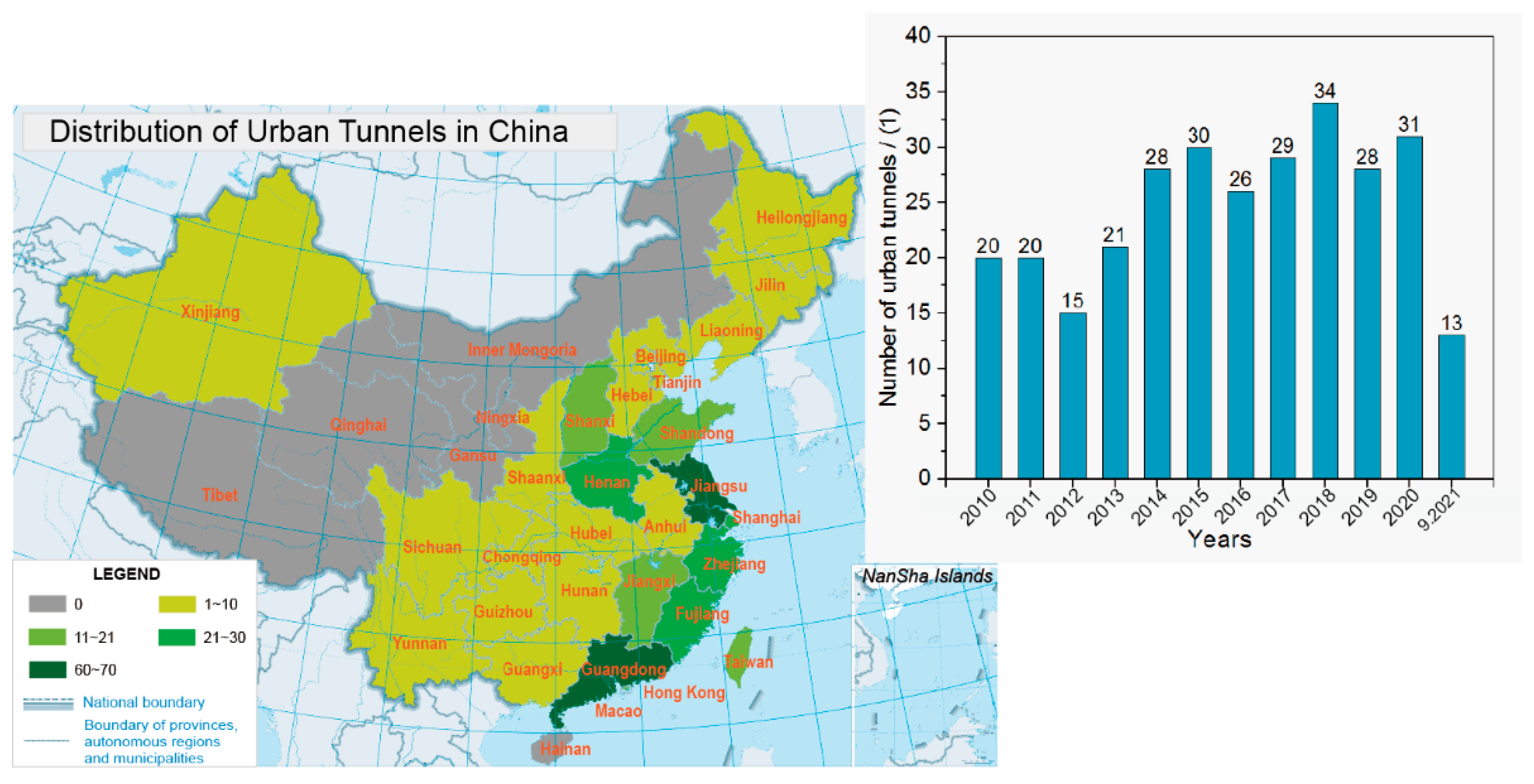
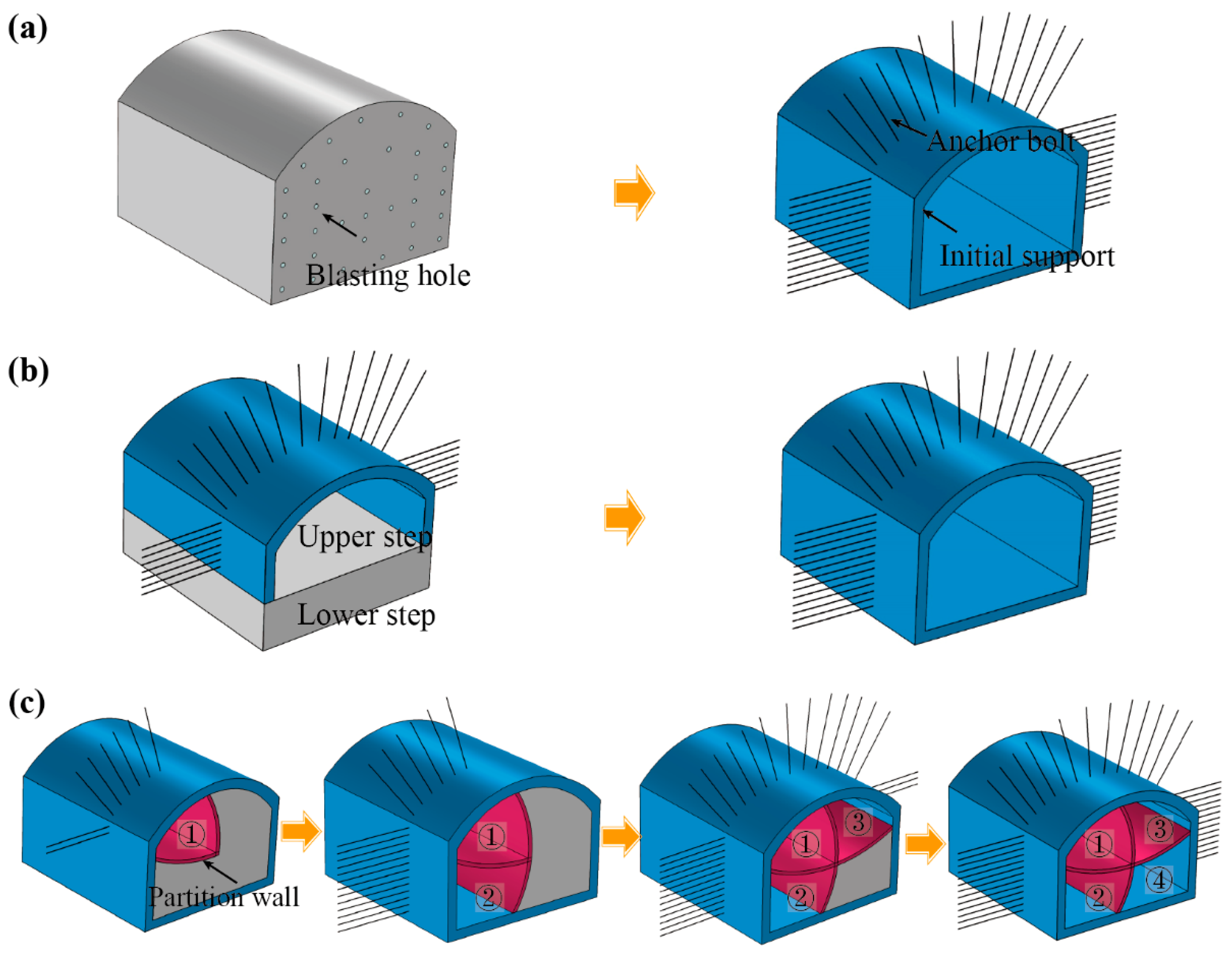
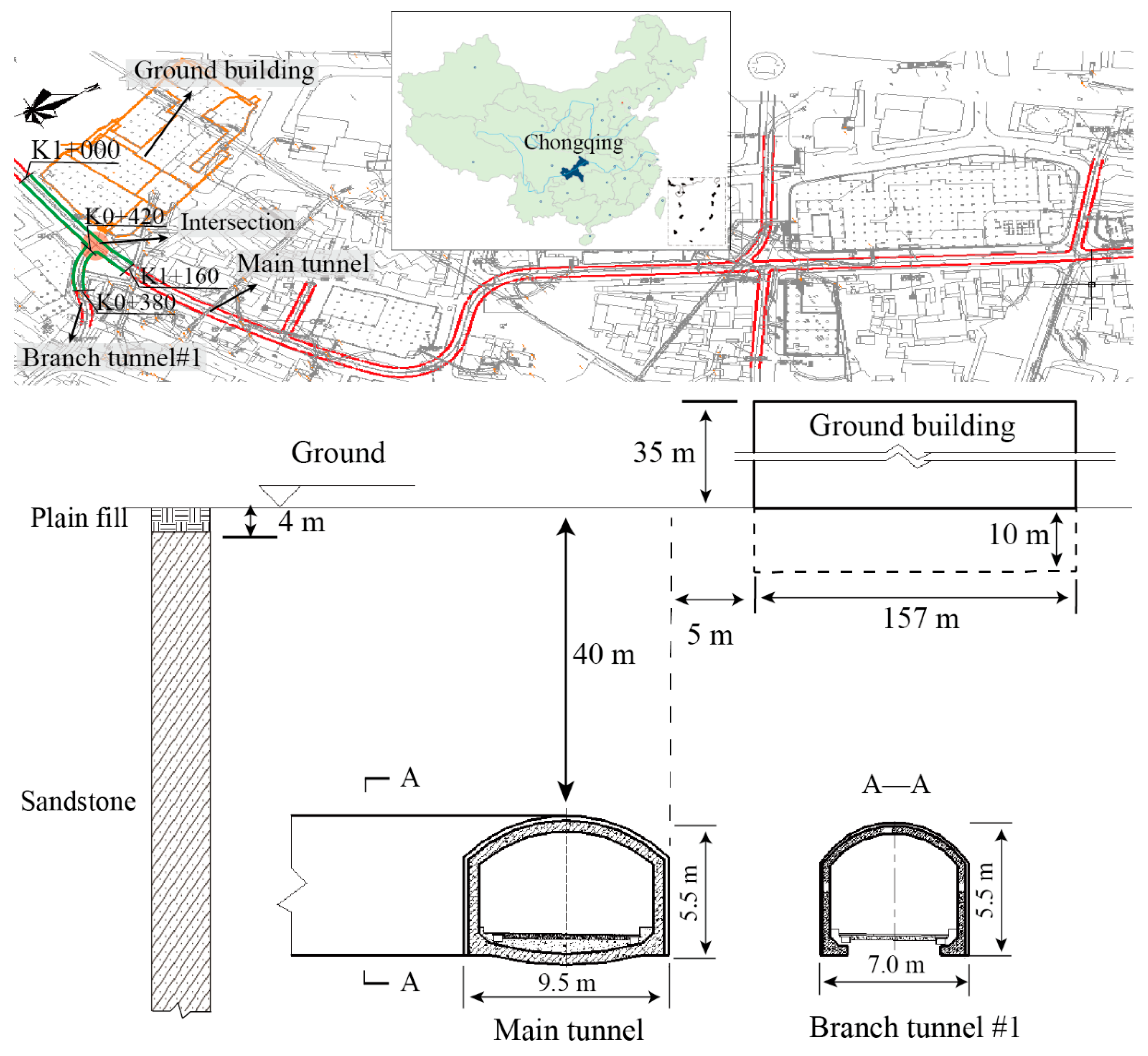

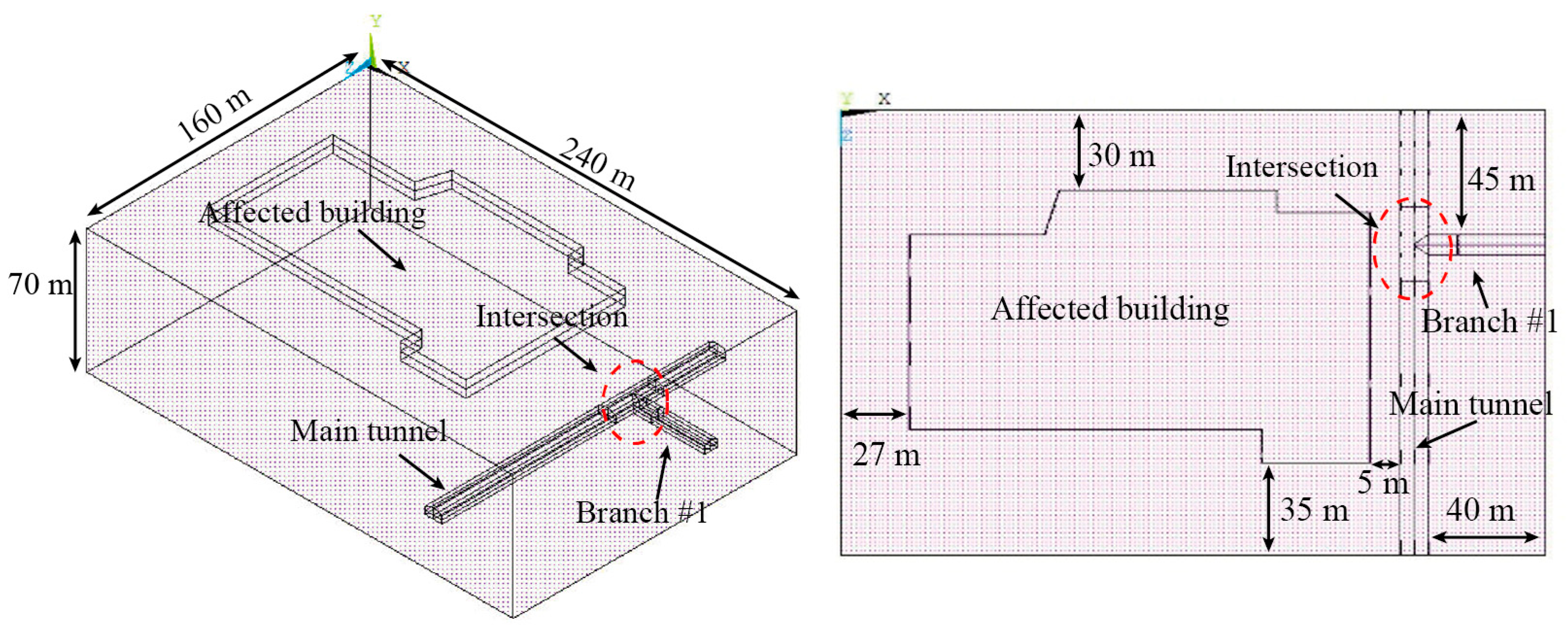
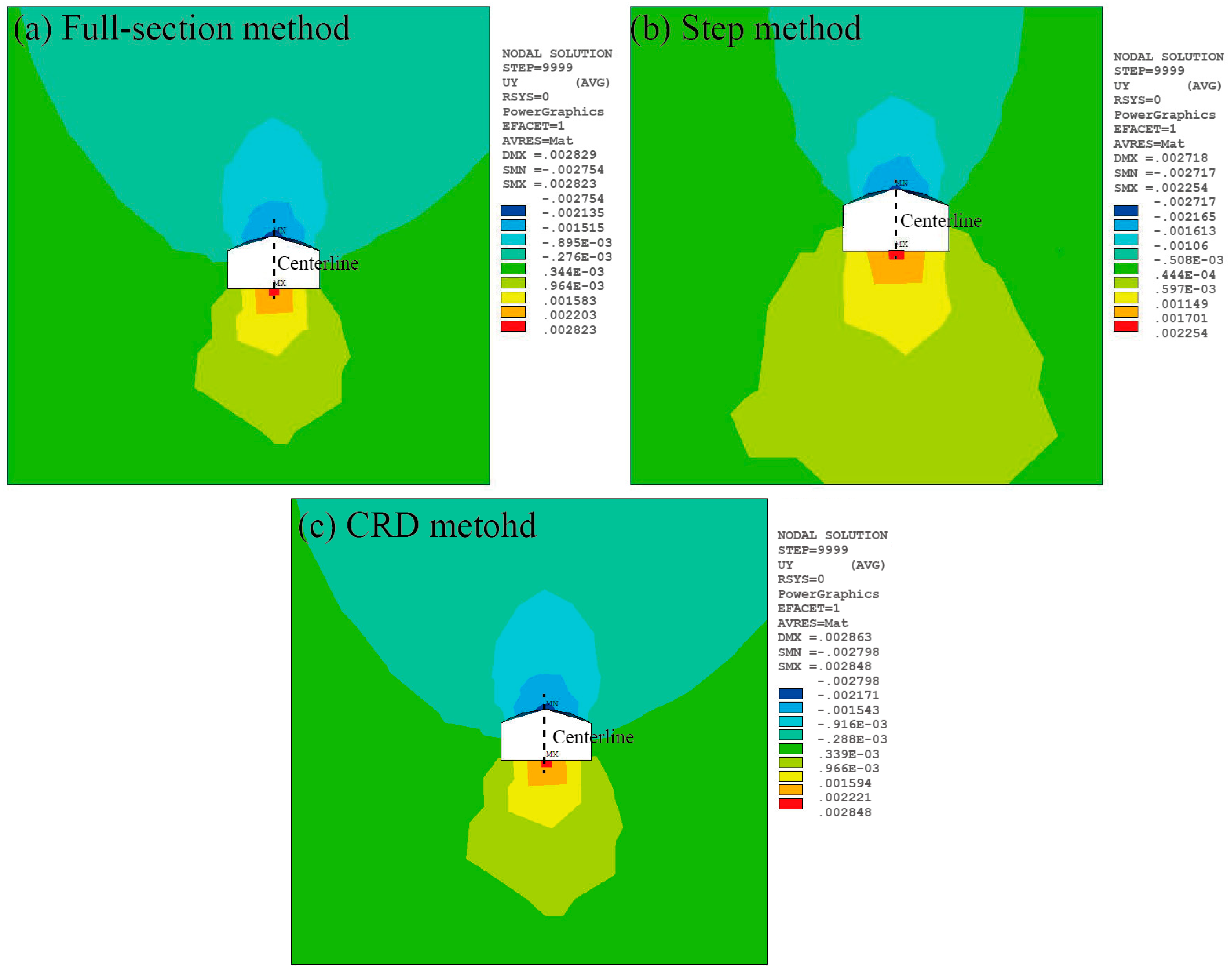
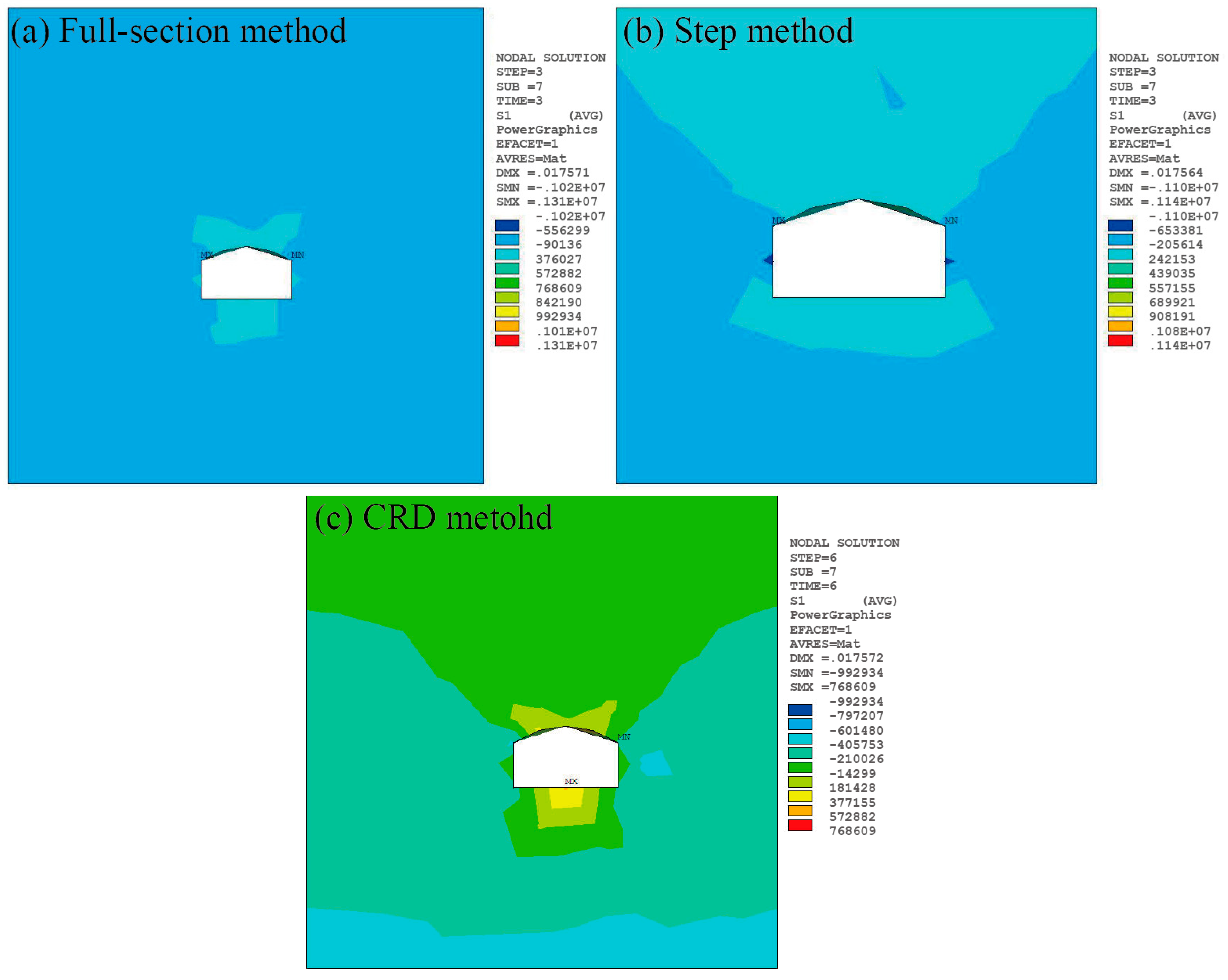

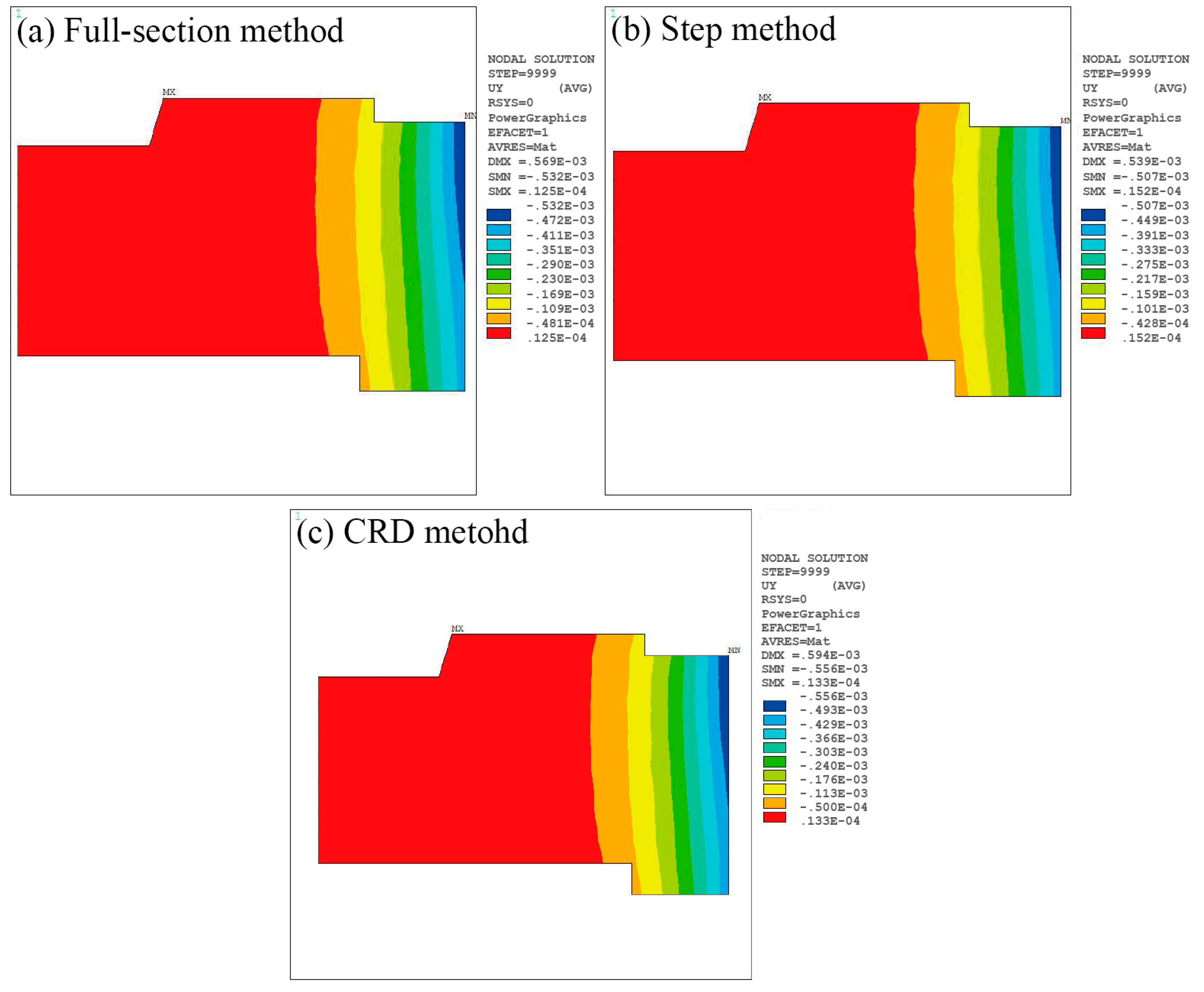
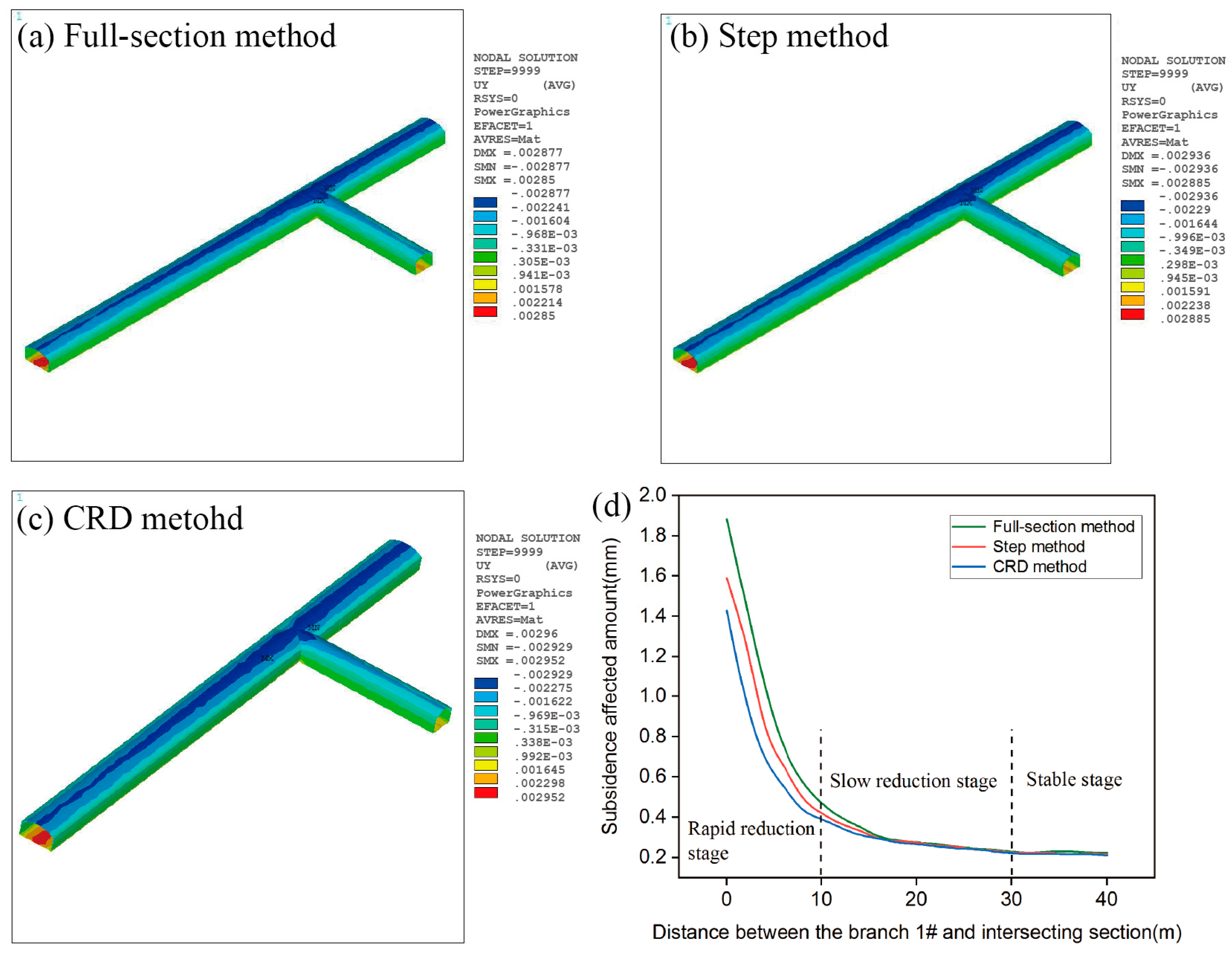
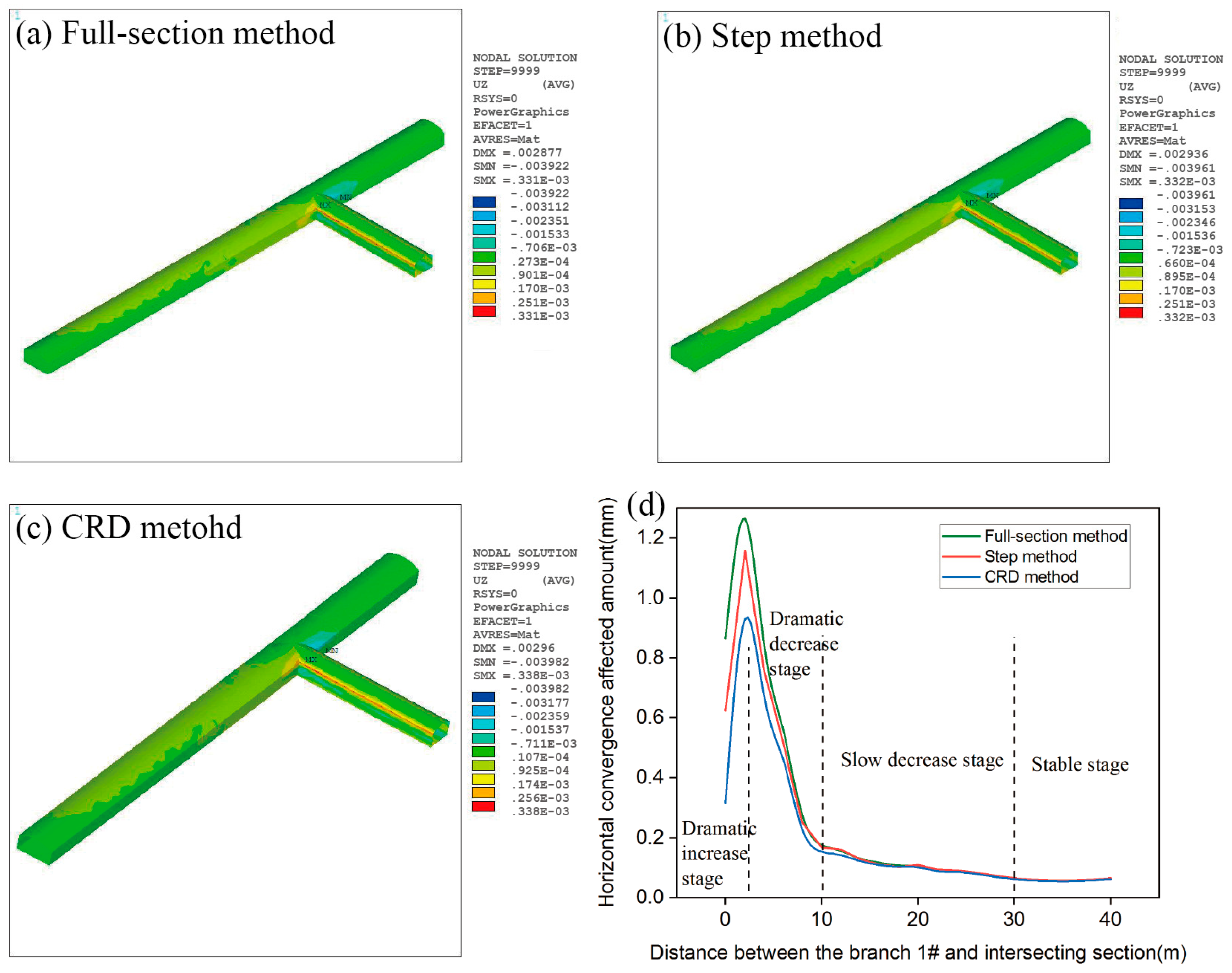
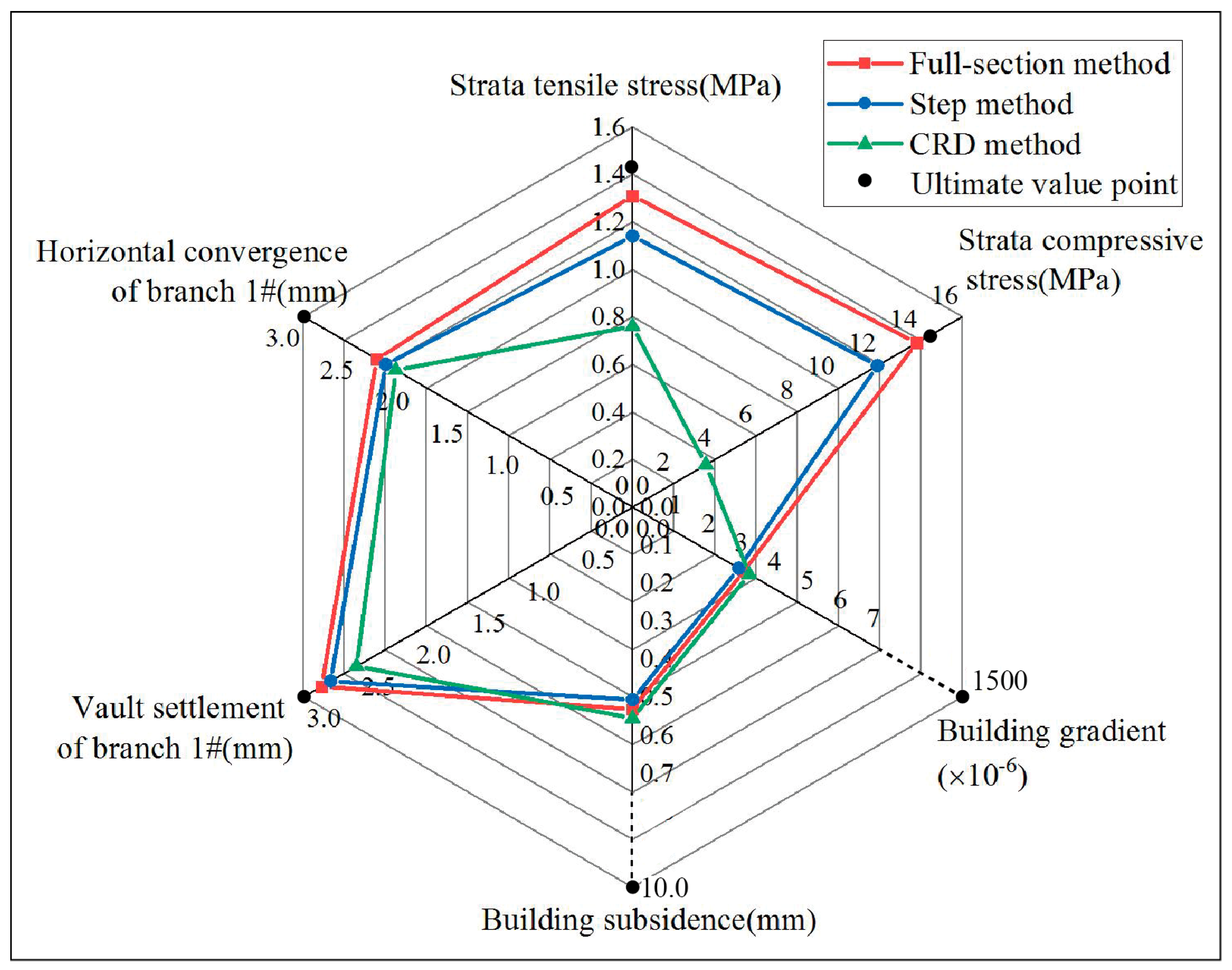

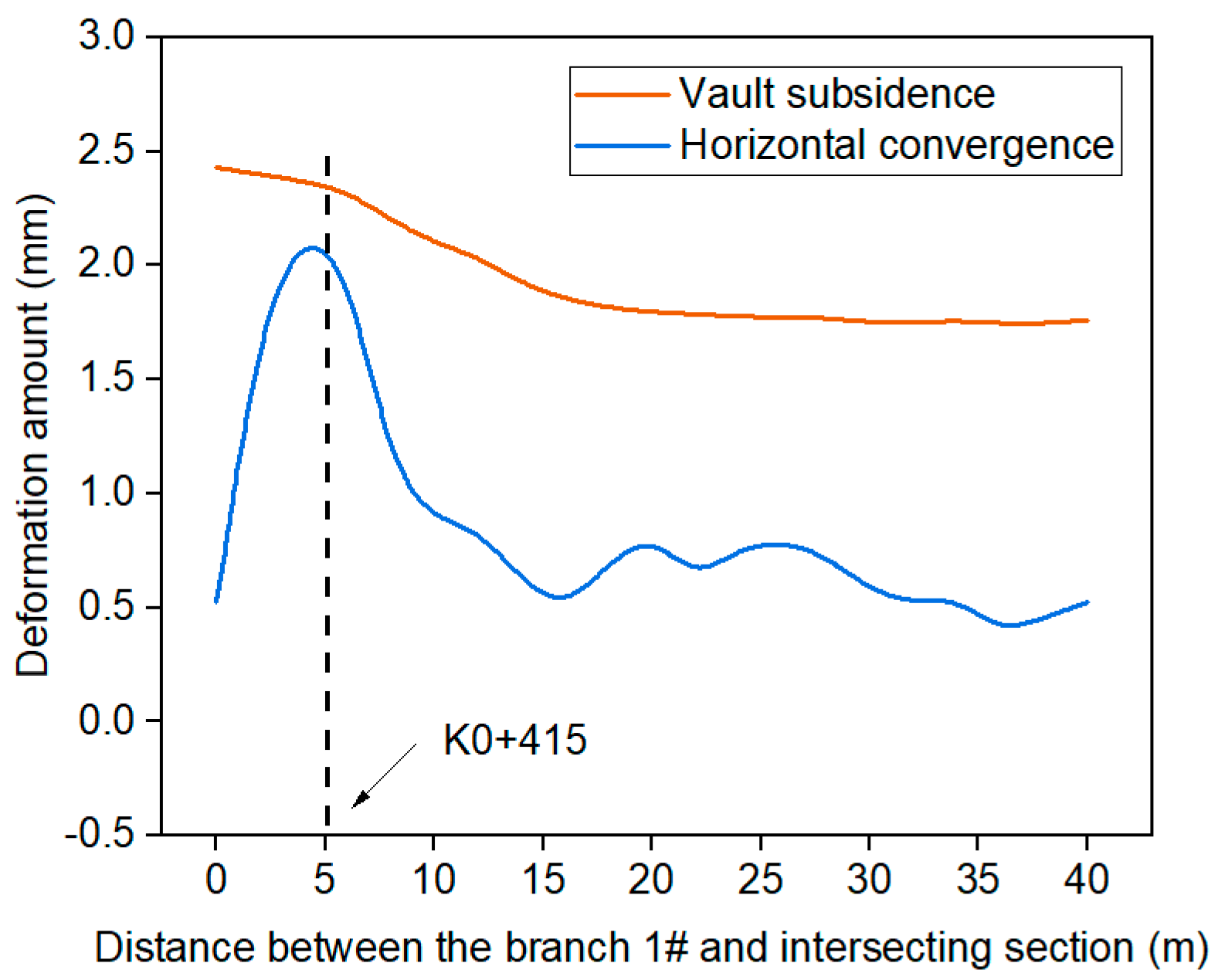
| Internal Friction Angle (º) | Cohesion (kPa) | Volumetric Weight (kN/m3) | Elasticity Modulus (MPa) | Poisson’s Ratio | |
|---|---|---|---|---|---|
| Plain fill | 11.5 | 23.3 | 18.5 | 1.7 | 0.16 |
| Sandstone | 32.9 | 744.0 | 25.9 | 3500.0 | 0.23 |
| Element Type | Internal Friction Angle (º) | Cohesion (kPa) | Volumetric Weight (kN/m3) | Elasticity Modulus (GPa) | Poisson’s Ratio | |
|---|---|---|---|---|---|---|
| Surrounding rock | Solid92 | 32.9 | 744.0 | 25.9 | 3.5 | 0.23 |
| Ground building | Solid92 | - | - | 25.0 | 33.0 | 0.20 |
| Anchor bolt | Link8 | - | - | 79.0 | 200.0 | 0.20 |
| C30 concrete | Shell93 | - | - | 25.0 | 30.0 | 0.20 |
| Construction Methods | The Maximum Vault Settlement Amount (mm) | The Maximum Floor Uplift Amount (mm) | The Maximum Compressive Stress (MPa) | The Maximum Tensile Stress (MPa) |
|---|---|---|---|---|
| Full-section method | 2.754 | 2.823 | 13.80 | 1.31 |
| Step method | 2.717 | 2.254 | 11.90 | 1.14 |
| CRD method | 2.798 | 2.848 | 3.56 | 0.76 |
| Construction Methods | The Maximum Settlement Amount (Mm) | The Maximum Gradient Value (‰) |
|---|---|---|
| Full-section method | 0.523 | 0.00338 |
| Step method | 0.507 | 0.00323 |
| CRD method | 0.556 | 0.00354 |
| Lining Materials | Safe Compressive Strength (MPa) | Safe Tensile Strength (MPa) |
|---|---|---|
| Concrete C30 | 14.30 | 1.43 |
| Types | Accumulated Value (mm) |
|---|---|
| Settlement of tunnel structure | 3~10 |
| Horizontal displacement of tunnel structure | 3~5 |
| Height of Building (m) | Allowable Gradient Value | Allowable Foundation Settlement Gradient (mm) | Safety Coefficient |
|---|---|---|---|
| 24 < H ≤ 60 | 0.003 | 20 | 0.5 |
| Safe Compressive Strength (MPa) | Safe Tensile Strength (MPa) | Allowable Gradient Value | Allowable Foundation Settlement (mm) | Allowable Vault Settlement (mm) | Allowable Horizontal Convergence (mm) | |
|---|---|---|---|---|---|---|
| Surrounding rock | 14.30 | 1.43 | - | - | - | |
| Branch tunnel 1# | - | - | - | - | 3 | 3 |
| Ground building | - | - | 0.0015 | 10 | - | - |
| The Maximum Vault Settlement | The Maximum Horizontal Convergence | |
|---|---|---|
| Field monitoring | 2.480 mm | 2.110 mm |
| Numerical simulation | 2.361 mm | 2.157 mm |
| Results error | 4.7% | 2.2% |
Disclaimer/Publisher’s Note: The statements, opinions and data contained in all publications are solely those of the individual author(s) and contributor(s) and not of MDPI and/or the editor(s). MDPI and/or the editor(s) disclaim responsibility for any injury to people or property resulting from any ideas, methods, instructions or products referred to in the content. |
© 2023 by the authors. Licensee MDPI, Basel, Switzerland. This article is an open access article distributed under the terms and conditions of the Creative Commons Attribution (CC BY) license (https://creativecommons.org/licenses/by/4.0/).
Share and Cite
Ren, Y.; Zhou, S.; Jia, J.; Yuan, Q.; Liu, M.; Song, S.; Zhou, Z.; Wang, Z. The Influence of Construction Methods on the Stability of Tunnels and Ground Structures in the Construction of Urban Intersection Tunnels. Sustainability 2023, 15, 14720. https://doi.org/10.3390/su152014720
Ren Y, Zhou S, Jia J, Yuan Q, Liu M, Song S, Zhou Z, Wang Z. The Influence of Construction Methods on the Stability of Tunnels and Ground Structures in the Construction of Urban Intersection Tunnels. Sustainability. 2023; 15(20):14720. https://doi.org/10.3390/su152014720
Chicago/Turabian StyleRen, Yiwei, Shijun Zhou, Jiayin Jia, Qiang Yuan, Maoyi Liu, Shuyi Song, Zelin Zhou, and Zhen Wang. 2023. "The Influence of Construction Methods on the Stability of Tunnels and Ground Structures in the Construction of Urban Intersection Tunnels" Sustainability 15, no. 20: 14720. https://doi.org/10.3390/su152014720
APA StyleRen, Y., Zhou, S., Jia, J., Yuan, Q., Liu, M., Song, S., Zhou, Z., & Wang, Z. (2023). The Influence of Construction Methods on the Stability of Tunnels and Ground Structures in the Construction of Urban Intersection Tunnels. Sustainability, 15(20), 14720. https://doi.org/10.3390/su152014720









